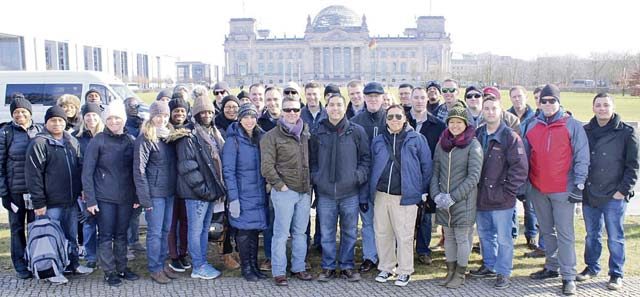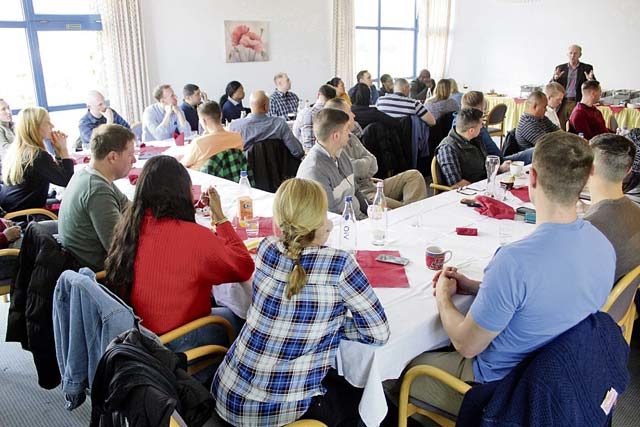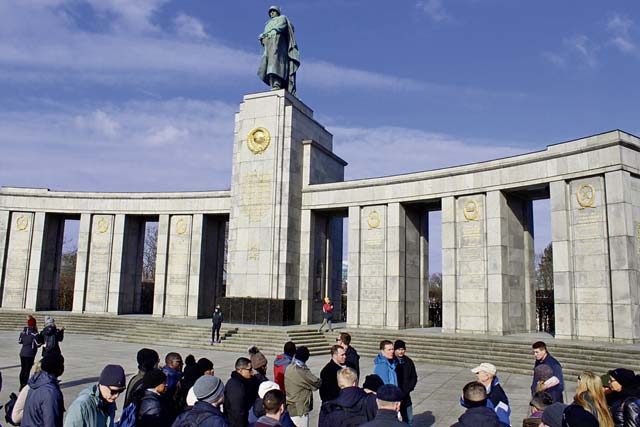
BERLIN — The 16th Sustainment Brigade conducted a staff ride to Berlin, Feb. 20 to 23, taking part in guided tours, seminars, and visits to sites of the Battle of Berlin. The ride concluded with an outing to the U.S. Embassy.
The innovative week sharpened leaders’ ethical and critical decision-making skills through a week of reflection on the Soviet-German battle.
“This week our leaders experienced a logistics-focused lesson centered on a large and important battle and in doing so embraced our profession and the meaning behind a Strong Europe,” said the Knight’s Brigade Commander, Col. Michelle Donahue. “An amazing learning opportunity, the staff ride also enabled 16th’s leaders to grapple with the past and present change in Europe’s operational environment and how recent events have led to multiple integration opportunities as well as a busy exercise schedule with our NATO allies — all intended to deter modern Russian aggression.”

The continent’s only Sustainment Brigade — the 16th — logistically supports U.S. Army Europe, and frequently works with not only its German allies, but also many other NATO alliance members.
“We’re here (on the staff ride) to work and learn,” said Lt. Col. Steven Schultz, the brigade’s deputy commander. “We arranged with the U.S. Army Europe Staff Ride Program to walk us through a unique and ambitious program. Ordinarily, a staff ride is just a study of the battle, in this case the Battle of Berlin, in which you would study the operational piece of the Soviet Army trying to encircle Berlin, the tactical piece of them going into the city and fighting house to house, etc.”
“We’re trying to do more this week,” Schultz continued. “In addition to studying the battle, and logistics operations in particular, we want to tell a story and try to answer two questions: Why are we here in Germany? How did the Russians go from wartime ally to strategic rival? By studying not just the Battle of Berlin, but the city in the 2nd half of the 20th Century, we think we can answer that question.”
The ride’s first stop set the tone for the rest of the tour: The House of the Wannsee Conference Memorial and Educational Site. It was here in 1942 that fifteen high-ranking Nazi representatives including the SS, party officials, and various ministries met to discuss with alarming clarity their plan to execute the Final Solution; the country’s deportation and murder of European Jews.
“What struck me about the Wannsee Conference was that the attendees were not concerned with the ‘why’ of the genocide but only the ‘how’,” said Capt. Michael McCarthy, a brigade assistant operations officer. “They didn’t discuss the morality of the actions they were about to carry out; instead they only talked about administrative and logistical strategies without regard to emotion.”
After a group discussion and a traditional local lunch, the group continued to Seelow Heights Museum, where the staff treated them to an audio-visual brief with an interactive terrain model illustrating an overview of the 1945 battle in this area.
“Walking Seelow Heights really drove the point home that the terrain models in the museum presented,” said Sgt. 1st Class Albert Schuler, the brigade’s Senior Property Book NCO. “The amount of terrain the Soviets covered in a short amount of time is amazing.”
The Battle for Berlin in the spring of 1945, the last major European land battle, was one of the epic confrontations of World War II. Outnumbered and outgunned by nearly ten to one, German armed forces defended their capital against the tenacious and vengeful Soviets hell-bent on conquering it. The battles in Seelow Heights preceded the final Berlin Battle. A hollow force of old men, sailors, airmen, and Hitler Youth manned the Berlin barricades for the Third Reich’s last stand, as the Russian bombs and later artillery pounded it. Berlin’s capture, one of the bloodiest and most desperate chapters in military history, was the ultimate prize for Stalin.
“There was so much that was done in sustainment back in the war,” said Col. (Ret.) Peter Herrly, the Paris-based retired American colonel who manages U.S. Army Europe’s staff rides. “Even though it’s been 70-plus years, this group is learning from the echoes of the past about how to improve what they’re doing today.”
Herrly led the bus down the street to the last site on the first day, the Soviet’s wet gap crossing of the Oder River, where the Knights had a bird’s eye view of the main bridge the Soviets used for their march on Berlin.

The first evening ended with a discussion of the day’s events and a meal at the hotel.
Day two started with a frontier battle site tour, including the Reitwien Spur, Marshal Georgi Konstantinovich Zhukov’s command post, Sachsendorf’s strongpoint defense, the Saumburg feature, and a German engagement area. Herrly led the 16th Soldiers in an analysis of the advantages and disadvantages of each site from where the Russians attacked and from where the Germans defended.
At lunch that day Herrly led an interesting discussion on that morning’s visits from a logistics viewpoint.
That afternoon the brigade hiked to the top of a German Flak Tower, one of a few German munitions strongholds the Soviets bypassed on their approach from the east into the center of the city. The staff had excellent views of the city and received an overview of the Russian route from the outskirts near Seelow into the city center from Herrly.
“The sheer scale of the operation was incredible.” said Capt. Jon Bobb, the brigade’s Finance Officer and one of the unit’s premier junior leaders. “I learned more in three days than in every history class I’ve ever attended.”
The group held a lively round table discussion on lessons learned on how the Russians sustained an army of 2.5 million soldiers thousands of miles from their home base. Dinner at the hotel rounded out the full day.
“Most battle fields I have previously toured were in the U.S. and focused on the American Revolutionary War and the American Civil War,” said 1st Lt. Michael Cavallo, a human resources officer with the brigade. “Walking the grounds of a modern battlefield from just 70 years ago has that much stronger of an impact and has been a great learning experience.”
Thursday morning’s first stop was Berlin’s main train station, where the Russians mounted the attack on the heart of the German capital, the Reichstag building. Herrly led the Knights over the Moltke Bridge, just as the Russian troops did in 1945, for their frontal assault of the building that was and is the heart of the German government.
“Walking in the Soviet’s footsteps was an experience that was eye opening and enlightening.” said Capt. Daniel Burkholder, a brigade operations officer. “We reimagined some of the conditions and discussed how some logistical challenges from the German and Soviet Union perspective are still applicable today.”
Lunch at a local restaurant provided a rest stop to warm up, as the Knights luckily had cold but clear skies all week.
That afternoon the logisticians also visited the Soviet War Memorial which commemorates the Russian soldiers killed seizing the Reichstag. The group passed through the large and morose outdoor Holocaust Memorial and reflected on the artistic design, intended symbolism, and themes. They passed an unassuming parking lot with a small plaque indicating the ground above what was Hitler’s Bunker, where he and many Nazi high command officials carried out the end of the war and committed suicide. Everyone toured the former Gestapo Headquarters, a segment of the Berlin Wall, and the “Checkpoint Charlie” Museum before discussing the Cold War on the bus ride home and at that evening’s seminar to wrap up the day.
On the last day, the staff participated in a leadership conference at the Embassy on the political, economic, and military landscape that drives German national security policy and the capabilities and limitations of the Bundeswehr. The visit concluded with a German army perspective given by Oberst I.G. Stuss from the German Army Headquarters in Strasbourg. The brigade, the State Department, and the Bundeswehr discussed issues concerning theater sustainment, interoperability, and multinational readiness.
Ironically, according to Schultz, the predecessor of today’s German army pioneered staff rides. After their defeat to Napoleon at Jena, the Prussians had a deep, collective group think about war and reformed their army in several ways, many of which other Western armies have adopted. One of the items the reformers came up with was the staff ride, in which they took their junior leaders on horseback to battlefields to walk, talk, and reenact the battles to see what they could have done differently.



